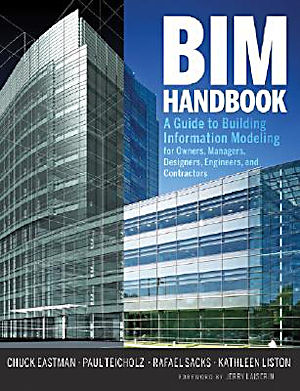
Full title: Eastman, Chuck, et al., BIM Handbook: a guide to building information modelling for owners, managers, designers, engineers, and contractors, John Wiley & Sons Inc, 2008
This book has been in my shelf for a few months, and I finally did an in-depth browsing of its contents. I will most likely use it as one of the book overviews for the forthcoming Arkus publication.
Chuck Eastman is considered to be the father of the concept of Building Information Modeling, and I honestly expected a pretty narrowed down definition with little design performance. Instead, I do think that it gives a fairly wide overview of the notion of BIM. The book is pretty much a school book on these issues, and takes a very positive attitude. The reason for this being possible may be that Eastman includes aspects that others may not define as BIM (such as conceptual design models). In the end, I care less for the word BIM than for the actual links he establishes.
The book gives a brief history to CAD in Architecture, Engineering and Construction organizations (AEC), and early on establishes that a BIM model must be digital, spatial, measurable, have associated objects, be accessible to the entire design and production team, be durable (beyond the completion of a building) and comprehensive. Pure digital models with no additional data, no integrated behavior, and lack of integration (using a collection of separate 2d drawings) cannot be defined as developed through BIM in this definition. He also covers initiatives as Industry Foundation Classes (IFC), and a variety of digital exchange formats.
He gives an overview over the most common software applying these principles (including GC and Digital Projects as well as more low end CAD-applications), with pros and cons. In different chapters he suggests benefits for owners and facility managers, architects and engineers, the construction industry as well as subcontractors and fabricators. There are many important issues brought up, although in depth discussions on how the work is organized, especially in relation to conceptual and collaborative design may be a little vague. As an introduction, each chapter is quite adequate though.
10 Case studies are used, mostly complex American projects, including the San Francisco Federal Building (Morphosis), 100 11th Avenue NYC (Nouvel) and the National Aquatic Center in Bejing (Water Cube pavilion, PTW), giving interesting overviews of what tools were applied, and also drawing conclusions. In this part the conceptual aspects of the projects are given some thought, as well as how collaborative teams were assembled.
Chapter 8, The Future: Building with BIM, speculates on new important roles, skill sets and services provided for professionals, as well as the impact on construction companies, contracting procedures, construction education, authorities and legislation, project documentation and research (as part of project processes).
A critical comment can be associated to Lars Hesselgren´s presentations last week, in which he suggested that BIM in itself is not necessary, it is the ability to deliver any kind of format from the working models (of the architect) to each participating party that is relevant, in effect bypassing a collective Building Information Model. What Lars did not get into was a bi-directional exchange, i.e. how participants can influence each other both ways. The book is focused on the construction professional, although the impact and potential for architectural innovation is also covered to certain extents. As a schoolbook on BIM from this perspective, there is no critical discussion on the architectural value of the approach per se, apart from the fact that innovative forms and structures can be made possible.
Leave a Reply